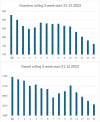Mä vähän luulen, että jos ryssänpaskiaiset ampuis pari nukee Eurooppaan,niin sen jälkeen Euroopassa alettais neuvottelemaan ja pidettäis palaveria palaverin jälkeen ja sitten jahkailtais ja lopulta olis useampi vuosi mennyt kun oltais pohdittu mitä pitäis tehdä ja mitään ei oltais saatu aikaseksi. Ikävä kyllä.Mikäs siinä, sopiihan se, mutta vastaisku kaikkiin suurempiin kaupunkeihin ryssälässä, Moskovat ja Pietarit ensimmäiseksi tasaiseksi.
Install the app
How to install the app on iOS
Follow along with the video below to see how to install our site as a web app on your home screen.
Note: This feature may not be available in some browsers.
You are using an out of date browser. It may not display this or other websites correctly.
You should upgrade or use an alternative browser.
You should upgrade or use an alternative browser.
Ukrainan konflikti/sota
Venäläisupseerin mukaan syy 70-luvun ZILien käyttöön sodassa on niiden sytytysjärjestlmä joka ei aiheuta häiriöitä elektroniikkaan, hänen mukaansa vanhat vehkeet ovat ylensä sotasaalista. Venäläinen on taitava keksimään selityksiä sotilaallisen suurvallan vaikeuksille.
https://www.mk.ru/politics/2024/04/08/oficer-obyasnil-ispolzovanie-na-svo-gruzovikov-70kh-godov.html
Oikea syy on Zilin kyvykkyys räjäyttää miinat etukäteen. Tämä tapahtuu supertieteellisen marssinopeuteen viritetyn resonoinnin välityksellä. Zilin kyydissä istuneet tietää, muuten ETS.
Antares
Respected Leader
Keskiviikko tuli ja meni, joten tässä Stanimir Dobrevin kuvaajat taas.
Näihin on lisätty viime viikon eli viikon 14 bensiinin ja dieselin tuotantomäärät (koko viikon tuotanto yhteenlaskettuna), sellaisina kuin Rosstat ne kertoo:
Russian gasoline production the week of 1st-7th of April declined again to 754 400 tons and diesel production dropped further than before to 1 585 100 tons.
In 2023 during the week of 3rd-9th of April gasoline production was 833 200 tons and diesel production was 1 769 000 tons.
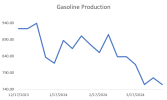
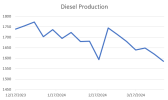
Gasoline prices for Ai-92 rose slightly from 50,62 rubles to 50,67 rubles per liter. For Ai-95 also rose slightly from 55,30 rubles to 55,41 rubles and for Ai-98 prices rose from 68,70 rubles to 68,91 rubles.
Link to the gasoline and diesel production from the prior week: LINKKI
If gasoline production stays at around 755 000 tons a week even support from Belarus will not be enough to prevent significant withdraws from storage even if that storage should by now be 1 800 000 tons of gasoline of all types.
-
(hän linkittää 4.4.2024 julkaistun viestinsä, lainaan sen tähän alle viivojen väliin)
We have data on Belarus' gasoline exports to Russia. They are 100-150 000 tons gasoline per month which if Russian production is between 750-770 000 will not be enough to cover the deficit.
https://www.kommersant.ru/doc/6617250
-
And Kazakhstan can only offer Russia 100 000 tons from what the Reuters reported on :
https://www.reuters.com/business/en...khstan-case-shortages-sources-say-2024-04-08/
April 8, 2024
5:52 PM GMT+3
Updated 3 days ago
MOSCOW, April 8 (Reuters) - Russia has asked Kazakhstan to stand ready to supply it with 100,000 tons of gasoline in case of shortages exacerbated by Ukrainian drone attacks and outages, three industry sources told Reuters.
One of the sources said a deal on using reserves for Russia has already been agreed.
Shyngys Ilyasov, an advisor to Kazakhstan's energy minister, said the energy ministry has not received such a request from its Russian counterpart.
Russian energy ministry did not reply to a request for comment.
Neighbouring Belarus has already agreed to help Russia with gasoline supply.
Drone attacks had knocked out some 14% of Russian primary oil refining capacity as of end-March. So far authorities have said the situation on domestic fuel markets is stable and stockpiles large enough.
Russia is usually a net exporter of fuel and a supplier to international markets but the refinery disruptions have forced its oil companies to import.
The sources said Moscow asked Kazakhstan to set up an emergency reserve of 100,000 metric tons of gasoline ready to supply to Russia.
Moscow imposed a gasoline export ban for six months from March 1 to prevent acute fuel shortages, although it does not apply to the Moscow-led Eurasian economic union, including Kazakhstan, as well as some countries, such as Mongolia, with which it has inter-government deals on fuel suppliers.
However, traders said the ban could be widened if the situation in Russia worsens.
Last week, the Orsk oil refinery in the Urals halted production due to widespread floods, which also affected Kazakhstan.
Kazakhstan, the world's largest land-locked country, has also restricted fuel exports until the end of the year, apart from for humanitarian purposes.
According to the sources, Kazakhstan's reserves of Ai-92 gasoline stood at 307,700 tons as of April 5 and Ai-95 gasoline stockpiles at 58,000 tons. Diesel reserves were 435,300 tons and jet fuel inventories totalled 101,000 tons.
-
The Reuters Power Up newsletter provides everything you need to know about the global energy industry. Sign up here.
Reporting by Reuters; writing by Vladimir Soldatkin; Editing by Kirsten Donovan
Also reminder that today we learned that some of the refinery repairs will take months : (alla lainattu teksti ja lähde julkaistu 10.4.2024)
Lukoil's Nizhny Novgorod refinery will manage to repair its refining installation АВТ-6 and catalytic cracking unit by H2 2024.
https://www.kommersant.ru/doc/6635870
Plus something to keep in mind for next Wednesday, the Orsk refinery is non operational this week due to the floods: (alla lainattu teksti ja lähde julkaistu 7.4.2024)
The Orsk refinery has stopped working due to flooding:
https://www.kommersant.ru/doc/6633692
-
Tässä vielä Dobrevin julkaisemista twitter-ketjuista poimitut tarkat numerot:

Viikolla 14 ei nähty rajua romahdusta eikä sellaista ehkä kannata odottaakaan. Bensiinin tilanne on tasoittunut "noin 750 - 775 tuhatta tonnia per viikko" tasolle mutta diesel on sukeltanut nopeasti viimeisen kolmen viikon aikana, suunta on lupaavasti alaspäin ja viikon 14 jalostusmäärä on uusi ennätys tällä seurantajaksolla eli pienin määrä per viikko (viikko 7 oli aikaisempi ennätyksenhaltija).
-
Dobrevin ketjusta selviää että 4.4.2024 julkaistun tiedon mukaan Valko-Venäjän bensiinin toimitukset Venäjälle olisivat kokoluokassa 100-150 000 tons gasoline per month eli jos tuon jakaa neljällä, saa keskiarvoiseksi yhden viikon toimitusmääräksi 25 - 37,5 tuhatta tonnia per viikko.
Dobrev myös tulkitsee Reuters uutista siten että Kazakstan kykenisi toimittamaan 100 tuhatta tonnia mutta on epäselvää, millä tahdilla ja onko tässä kaikki mihin suostuvat / kykenevät.
-
Muistutuksena myös että Dobrev on kirjoittanut ryssän bensiinin kulutuksesta näin, lainasin tämän aikaisemmassa viestissäni josta kopioin tekstit tähän alle (viesti julkaistu 5.4.2024): LINKKI
Tässä vielä yksi lisätieto ryssän bensiinin osalta: Stanimir Dobrevin tuoreimman tilannakatsauksen kommenteissa häneltä kysyttiin tietoa / arviota ryssän yhden viikon bensiinin kulutukselle.
Hän vastasi näin (LÄHDE):
Last data we had is from mid march at 794 000 tons per week: (alla oleva ketju on julkaistu 29.3.2024)
We have data on the Ru weekly consumption of gasoline for March, it rose by 13 000 tons per day in March to 794 000 tons a week and currently Ru oil firms are supplying more to the market than they are producing with 13-19 of Mar supply of 779 400 tons.
https://www.kommersant.ru/doc/6596233
-
The Russian oil companies are covering the deficit via an accumulated pool of 1,9 million tons of gasoline as of March 22nd. However a smaller part of that is high octane gasoline due its production being impacted for a while now.
The repairs of Lukoil's Nizhny Novgorod facility and its broken Western parts now are said to take not a few months but from several months to 2 and a half years. We also know the daily refining capacity of Ryazan and Syzran, 35 000 and 17 000 tons.
Based on Reuters assessment Russia's oil refining capacity due to emergency outages is down 13%. Preliminary Russian data suggested that refining for 2024 by March 20th decreased 7%. Due to available reserves shortages were avoided.
However it remains to be seen how Russia will handle April if attacks and breakdowns continue. And this is also impacted by Russian Railways' ability to ship gasoline within Russia which is 4 days slower than when shipping to export.
The country is operating 180 000 tank railway cars to move oil and petroleum products but since 2022 there's a shortage due to a high rate of write offs. 65 000 tank railway cars have been written off with just 16 000 new ones.
Also with the higher price of fuels on the wholesale market gas stations are close to losing money with the recent increases of 15% increases in March 2024 alone as the country nears the Spring refinery maintenance period.
-
MUOKKAUS: lisätään vielä tällainen tiedonmurunen, jolla Dobrev vastasi kysymykseen, voisiko hän piirtää kuvaajansa siten että niiden y-akselin skaala alkaisi nollasta (jolloin se olisi huonommin luettavissa ja kaikki vaihtelut näyttäisivät pienemmiltä)
I won't for two reasons, first that 760 000 - 740 000 tons is a point at which there are non trivial drawdowns from the gasoline stockpile and secondly it looks like this :
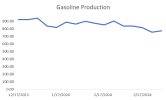
Näihin on lisätty viime viikon eli viikon 14 bensiinin ja dieselin tuotantomäärät (koko viikon tuotanto yhteenlaskettuna), sellaisina kuin Rosstat ne kertoo:
Russian gasoline production the week of 1st-7th of April declined again to 754 400 tons and diesel production dropped further than before to 1 585 100 tons.
In 2023 during the week of 3rd-9th of April gasoline production was 833 200 tons and diesel production was 1 769 000 tons.


Gasoline prices for Ai-92 rose slightly from 50,62 rubles to 50,67 rubles per liter. For Ai-95 also rose slightly from 55,30 rubles to 55,41 rubles and for Ai-98 prices rose from 68,70 rubles to 68,91 rubles.
Link to the gasoline and diesel production from the prior week: LINKKI
If gasoline production stays at around 755 000 tons a week even support from Belarus will not be enough to prevent significant withdraws from storage even if that storage should by now be 1 800 000 tons of gasoline of all types.
-
(hän linkittää 4.4.2024 julkaistun viestinsä, lainaan sen tähän alle viivojen väliin)
We have data on Belarus' gasoline exports to Russia. They are 100-150 000 tons gasoline per month which if Russian production is between 750-770 000 will not be enough to cover the deficit.
https://www.kommersant.ru/doc/6617250
04/04/2024, 00:54
26K2 minutes.8
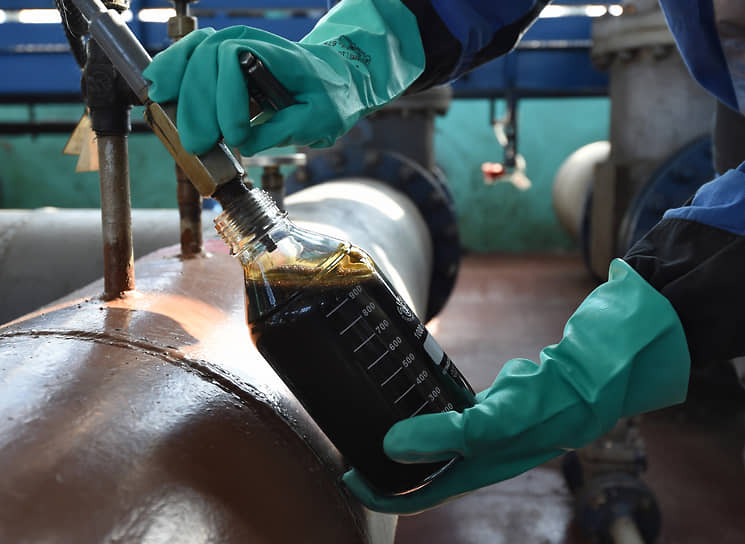
Photo: Dmitry Korotaev, Kommersant
Gasoline production in the Russian Federation in the last week of March amounted to 110.7 thousand tons per day, decreasing by 12% compared to the average daily figure in February, according to Rosstat data. Diesel fuel production decreased by 3.5%, to 231 thousand tons per day.
Russian refineries have reduced gasoline output mainly due to damage to primary processing units due to attacks by Ukrainian drones.
As a result of the attacks, installations at the Ryazan Oil Refinery (AT-6 and AVT-4), Kuibyshev Oil Refinery (AVT-4 and AVT-5), Syzran Oil Refinery (AVT-6), and Nizhny Novgorod Oil Refinery (AVT-6) were shut down.
Gasoline production may begin to recover in April as damaged units are brought back online. AVT-4 has already been restarted at the Ryazan Oil Refinery. The launch of AVT-6, according to industry data, was expected on April 3, but Kommersant has not yet been able to obtain confirmation that the installation is working. At the Kuibyshev Refinery, according to Kommersant’s interlocutors, both primary processing units can be commissioned approximately on May 8. AVT-6 of the Syzran Refinery may require the longest repair; the expected commissioning date is June 14. At the same time, the plant, according to Kommersant, is trying to organize the operation of the second AVT-5 unit, which has been idle since the summer of 2023. The commissioning of the AVT-6 unit at the Nizhny Novgorod Oil Refinery was planned or the end of March, but so far Kommersant’s interlocutors cannot say when it will be commissioned.
At the beginning of April, a technological breakdown occurred at the Astrakhan gas processing plant, but the plant plans to resume gasoline production on April 4.
“We plan to take a number of refineries out of repairs in April-May, maybe until the beginning of June. All facilities that were damaged will be brought back into service,” said the head of the Ministry of Energy, Nikolai Shulginov, on April 3.
Deputy Prime Minister for the Fuel and Energy Complex Alexander Novak said on April 3 that oil companies were tasked with loading operational refineries and increasing gasoline production “to eliminate possible risks associated with the market.”
As Kommersant noted on March 25 , despite the decrease in gasoline production, Russian oil companies have increased its supplies to the domestic market using accumulated reserves. As a result, after a sharp rise in wholesale prices in mid-March, last week gasoline fell in price on the St. Petersburg International Exchange. However, this week the price increase resumed, including due to the psychological effect of the drone attack on the Nizhnekamsk refinery on April 2 (the plant itself was not damaged). Thus, on April 3, AI-95 gasoline in the European part of the Russian Federation rose in price on the stock exchange by 1.5%, to 65.4 thousand rubles. per ton. Kommersant’s interlocutors believe that the price decline at the end of March was due to an improvement in the situation on the railway, as “petroleum products began to travel better.” In addition, the head of the Energy Committee of the State Duma of the Russian Federation, Pavel Zavalny, announced on March 28 that Belarus is ready to supply 100–150 thousand tons of gasoline per month to the Russian Federation to prevent fuel shortages. Although the Russian budget has been paying a damper on Belarusian oil products supplied to Russia since 2023, this remained an insufficient incentive for Belarusian refineries, since export supplies were more profitable.
Imports of gasoline from Belarus to Russia at the level of 100–150 thousand tons are a noticeable value, Petromarket notes; supplies were at this level in 2013–2014. In 2021–2023, imports were at zero level. The reason for stopping supplies is their unprofitability for the Belarusian side, according to Petromarket. But the current situation on the market, due to the departure of a number of Russian refineries for repairs, creates the prerequisites for the level of wholesale gasoline prices in Russia for Belarusian refineries to be quite comfortable, analysts conclude.
Dmitry Kozlov
26K2 minutes.8
Gasoline is out of stock
Production decreased unnoticed by the market
Russian oil refiners reduced gasoline production in the last week of March by 12% compared to the February average, according to Rosstat data. The decrease in fuel production is due to damage to refinery installations due to drone attacks. It is expected that most of the damaged installations will return to service during April-May. The domestic market has not yet noticed a shortage of gasoline due to the consumption of reserves, as well as a sharp increase in imports from Belarus.
Photo: Dmitry Korotaev, Kommersant
Gasoline production in the Russian Federation in the last week of March amounted to 110.7 thousand tons per day, decreasing by 12% compared to the average daily figure in February, according to Rosstat data. Diesel fuel production decreased by 3.5%, to 231 thousand tons per day.
Russian refineries have reduced gasoline output mainly due to damage to primary processing units due to attacks by Ukrainian drones.
As a result of the attacks, installations at the Ryazan Oil Refinery (AT-6 and AVT-4), Kuibyshev Oil Refinery (AVT-4 and AVT-5), Syzran Oil Refinery (AVT-6), and Nizhny Novgorod Oil Refinery (AVT-6) were shut down.
Gasoline production may begin to recover in April as damaged units are brought back online. AVT-4 has already been restarted at the Ryazan Oil Refinery. The launch of AVT-6, according to industry data, was expected on April 3, but Kommersant has not yet been able to obtain confirmation that the installation is working. At the Kuibyshev Refinery, according to Kommersant’s interlocutors, both primary processing units can be commissioned approximately on May 8. AVT-6 of the Syzran Refinery may require the longest repair; the expected commissioning date is June 14. At the same time, the plant, according to Kommersant, is trying to organize the operation of the second AVT-5 unit, which has been idle since the summer of 2023. The commissioning of the AVT-6 unit at the Nizhny Novgorod Oil Refinery was planned or the end of March, but so far Kommersant’s interlocutors cannot say when it will be commissioned.
At the beginning of April, a technological breakdown occurred at the Astrakhan gas processing plant, but the plant plans to resume gasoline production on April 4.
“We plan to take a number of refineries out of repairs in April-May, maybe until the beginning of June. All facilities that were damaged will be brought back into service,” said the head of the Ministry of Energy, Nikolai Shulginov, on April 3.
Deputy Prime Minister for the Fuel and Energy Complex Alexander Novak said on April 3 that oil companies were tasked with loading operational refineries and increasing gasoline production “to eliminate possible risks associated with the market.”
As Kommersant noted on March 25 , despite the decrease in gasoline production, Russian oil companies have increased its supplies to the domestic market using accumulated reserves. As a result, after a sharp rise in wholesale prices in mid-March, last week gasoline fell in price on the St. Petersburg International Exchange. However, this week the price increase resumed, including due to the psychological effect of the drone attack on the Nizhnekamsk refinery on April 2 (the plant itself was not damaged). Thus, on April 3, AI-95 gasoline in the European part of the Russian Federation rose in price on the stock exchange by 1.5%, to 65.4 thousand rubles. per ton. Kommersant’s interlocutors believe that the price decline at the end of March was due to an improvement in the situation on the railway, as “petroleum products began to travel better.” In addition, the head of the Energy Committee of the State Duma of the Russian Federation, Pavel Zavalny, announced on March 28 that Belarus is ready to supply 100–150 thousand tons of gasoline per month to the Russian Federation to prevent fuel shortages. Although the Russian budget has been paying a damper on Belarusian oil products supplied to Russia since 2023, this remained an insufficient incentive for Belarusian refineries, since export supplies were more profitable.
Imports of gasoline from Belarus to Russia at the level of 100–150 thousand tons are a noticeable value, Petromarket notes; supplies were at this level in 2013–2014. In 2021–2023, imports were at zero level. The reason for stopping supplies is their unprofitability for the Belarusian side, according to Petromarket. But the current situation on the market, due to the departure of a number of Russian refineries for repairs, creates the prerequisites for the level of wholesale gasoline prices in Russia for Belarusian refineries to be quite comfortable, analysts conclude.
Dmitry Kozlov
-
And Kazakhstan can only offer Russia 100 000 tons from what the Reuters reported on :
https://www.reuters.com/business/en...khstan-case-shortages-sources-say-2024-04-08/
Exclusive: Russia seeks gasoline from Kazakhstan in case of shortages, sources say
By ReutersApril 8, 2024
5:52 PM GMT+3
Updated 3 days ago
MOSCOW, April 8 (Reuters) - Russia has asked Kazakhstan to stand ready to supply it with 100,000 tons of gasoline in case of shortages exacerbated by Ukrainian drone attacks and outages, three industry sources told Reuters.
One of the sources said a deal on using reserves for Russia has already been agreed.
Shyngys Ilyasov, an advisor to Kazakhstan's energy minister, said the energy ministry has not received such a request from its Russian counterpart.
Russian energy ministry did not reply to a request for comment.
Neighbouring Belarus has already agreed to help Russia with gasoline supply.
Drone attacks had knocked out some 14% of Russian primary oil refining capacity as of end-March. So far authorities have said the situation on domestic fuel markets is stable and stockpiles large enough.
Russia is usually a net exporter of fuel and a supplier to international markets but the refinery disruptions have forced its oil companies to import.
The sources said Moscow asked Kazakhstan to set up an emergency reserve of 100,000 metric tons of gasoline ready to supply to Russia.
Moscow imposed a gasoline export ban for six months from March 1 to prevent acute fuel shortages, although it does not apply to the Moscow-led Eurasian economic union, including Kazakhstan, as well as some countries, such as Mongolia, with which it has inter-government deals on fuel suppliers.
However, traders said the ban could be widened if the situation in Russia worsens.
Last week, the Orsk oil refinery in the Urals halted production due to widespread floods, which also affected Kazakhstan.
Kazakhstan, the world's largest land-locked country, has also restricted fuel exports until the end of the year, apart from for humanitarian purposes.
According to the sources, Kazakhstan's reserves of Ai-92 gasoline stood at 307,700 tons as of April 5 and Ai-95 gasoline stockpiles at 58,000 tons. Diesel reserves were 435,300 tons and jet fuel inventories totalled 101,000 tons.
-
The Reuters Power Up newsletter provides everything you need to know about the global energy industry. Sign up here.
Reporting by Reuters; writing by Vladimir Soldatkin; Editing by Kirsten Donovan
Also reminder that today we learned that some of the refinery repairs will take months : (alla lainattu teksti ja lähde julkaistu 10.4.2024)
Lukoil's Nizhny Novgorod refinery will manage to repair its refining installation АВТ-6 and catalytic cracking unit by H2 2024.
https://www.kommersant.ru/doc/6635870
Plus something to keep in mind for next Wednesday, the Orsk refinery is non operational this week due to the floods: (alla lainattu teksti ja lähde julkaistu 7.4.2024)
The Orsk refinery has stopped working due to flooding:
https://www.kommersant.ru/doc/6633692
-
Tässä vielä Dobrevin julkaisemista twitter-ketjuista poimitut tarkat numerot:

Viikolla 14 ei nähty rajua romahdusta eikä sellaista ehkä kannata odottaakaan. Bensiinin tilanne on tasoittunut "noin 750 - 775 tuhatta tonnia per viikko" tasolle mutta diesel on sukeltanut nopeasti viimeisen kolmen viikon aikana, suunta on lupaavasti alaspäin ja viikon 14 jalostusmäärä on uusi ennätys tällä seurantajaksolla eli pienin määrä per viikko (viikko 7 oli aikaisempi ennätyksenhaltija).
-
Dobrevin ketjusta selviää että 4.4.2024 julkaistun tiedon mukaan Valko-Venäjän bensiinin toimitukset Venäjälle olisivat kokoluokassa 100-150 000 tons gasoline per month eli jos tuon jakaa neljällä, saa keskiarvoiseksi yhden viikon toimitusmääräksi 25 - 37,5 tuhatta tonnia per viikko.
Dobrev myös tulkitsee Reuters uutista siten että Kazakstan kykenisi toimittamaan 100 tuhatta tonnia mutta on epäselvää, millä tahdilla ja onko tässä kaikki mihin suostuvat / kykenevät.
-
Muistutuksena myös että Dobrev on kirjoittanut ryssän bensiinin kulutuksesta näin, lainasin tämän aikaisemmassa viestissäni josta kopioin tekstit tähän alle (viesti julkaistu 5.4.2024): LINKKI
Tässä vielä yksi lisätieto ryssän bensiinin osalta: Stanimir Dobrevin tuoreimman tilannakatsauksen kommenteissa häneltä kysyttiin tietoa / arviota ryssän yhden viikon bensiinin kulutukselle.
Hän vastasi näin (LÄHDE):
Last data we had is from mid march at 794 000 tons per week: (alla oleva ketju on julkaistu 29.3.2024)
We have data on the Ru weekly consumption of gasoline for March, it rose by 13 000 tons per day in March to 794 000 tons a week and currently Ru oil firms are supplying more to the market than they are producing with 13-19 of Mar supply of 779 400 tons.
https://www.kommersant.ru/doc/6596233
03/29/2024, 00:01
1K7 min.

Photo: Viktor Korotaev, Kommersant
The main task of the state and the Russian fuel and energy complex over the past two months has been to provide the domestic market with a sufficient amount of fuel. And so far it has succeeded. As reported by the Ministry of Energy, in March, gasoline shipments to Russian consumers showed an increase of 13 thousand tons per day compared to February (up to 794 thousand tons), diesel fuel - by 15.5 thousand tons per day. At the same time, according to the Central Dispatch Department of the Fuel and Energy Complex, in mid-March the volume of supplies exceeded the volume of production for the first time since September 2023. During the week of March 13–19, it fell by 3.9% relative to the previous week and by 5.2% relative to the planned level - to 779.4 thousand tons (111.3 thousand tons per day). Oil companies were able to cover the difference between these values using accumulated reserves of petroleum products, which as of March 22 amounted to 1.9 million tons of gasoline and 3.4 million tons of diesel fuel.
The risk of a fuel shortage has arisen due to the shutdown of refining capacities at a number of plants. The first to fail at the very beginning of the year was the catalytic cracking unit at one of the largest Russian sites - the Nizhny Novgorod Oil Refinery of LUKOIL (capacity - 200 thousand tons per month). The reason was the breakdown of foreign compressor equipment, which cannot yet be replaced due to Western sanctions. According to authorities, finding an alternative and repairing it will take from several months to a year and a half. In the next two months, accidents due to drone attacks occurred at LUKOIL's Volgograd Refinery, Rosneft's Tuapse Refinery and Ilsky Refinery in the Krasnodar Territory. But the damage to their capacities did not significantly affect the supply of the domestic market, since the factories worked largely for export.
Russian oil workers suffered more significant losses in March. Thus, on March 12, drones damaged a primary oil refining unit at the Nizhny Novgorod Oil Refinery of LUKOIL, which accounts for 53% of the plant’s capacity. Its failure can lead to an almost twofold reduction in diesel fuel output and a quarter reduction in gasoline output. Drone attacks on March 13 and 16 disabled two similar installations at the Ryazan Oil Refinery (capacity - about 35 thousand tons per day) and one at the Syzran Oil Refinery (17 thousand tons). Both enterprises belong to Rosneft. The reduction in motor gasoline production at RNPK could be about 35%, despite a 70% reduction in plant utilization, if cat cracking is provided with raw materials in the required volume, Reuters calculated. The drop in the production of motor gasoline and diesel fuel at the three sites could amount to up to 5.8% and 6.6% of total Russian production, respectively. But such a reduction, market participants believe, will not be critical and can be compensated by other Russian refineries, which in the low season have sufficient capacity to produce additional volumes of fuel. Reuters estimates the overall productivity of primary oil refining units that are in emergency shutdown after the attacks at 13% of the total capacity in the Russian Federation.
Despite unscheduled repairs at these refineries, the Ministry of Energy predicts the volume of primary oil refining in 2024 at last year’s level. At the end of 2023, oil refining in Russia increased by 1.2%, to 275 million tons. “The forecast for oil refining volume remains at a level close to last year,” said the head of the ministry, Nikolai Shulginov, on March 20. At the end of February, he reported that oil refining had decreased by about 7% since the beginning of 2024. But later, First Deputy Head of the Ministry of Energy Pavel Sorokin said that primary processing at the end of this year will be lower than last year, but due to these volumes Russia will increase exports.
Sergei Kondratyev from the Institute of Energy and Finance predicts that by the end of March output will likely be 4% below plan, which, taking into account available reserves, will avoid a shortage on the domestic market. In April, in his opinion, the situation on the fuel market will depend on how quickly it is possible to return damaged installations to operation and additionally load other refineries.
To prevent fuel shortages on the domestic market, the government has taken a number of measures. The first step was a ban on the export of all types of gasoline introduced on March 1 until August 31. The exception is supplies within the framework of international intergovernmental agreements, including member states of the Eurasian Economic Union, as well as for fuel exported by citizens for personal use and for the provision of international humanitarian assistance. Also, from March 1, the standard for the sale of diesel fuel at exchange trading was increased from 12.5% to 16%.
But the introduction of an embargo on gasoline exports disrupted the usual logistics models, which complicated the situation with rail shipments. First of all, there was confusion with the directions and priority of shipments. The point is that some cargo is exported from Russia as a matter of priority. These are military cargo, cargo for emergency response, as well as cargo on behalf of the president, including the export of coal from Kuzbass, Khakassia, Tuva, Irkutsk region, Buryatia and Yakutia.
Now this list may also include petroleum products. According to Kommersant, fuel will receive increased priority on the railway in relation to other cargo. Following a meeting on the situation on the domestic petroleum products market on March 22, Deputy Prime Minister Alexander Novak instructed oil companies, together with Russian Railways, to “ensure uninterrupted export of petroleum products and loading of refineries in accordance with the schedule and growing spring demand.” As part of these instructions, the Ministry of Energy, oil companies and Russian Railways are developing monthly schedules for the transportation of petroleum products, the implementation of which will be monitored by the government.
The transport monopoly itself stated that the railways have already adapted to the new situation. “The change in existing supply chains required a significant restructuring of the technological process. We interact with oil companies and tank owners around the clock. We have reallocated resources for timely processing of trains at loading and unloading stations,” notes Russian Railways. According to the company, loading of petroleum products on the domestic market for the week from March 18 to March 24 increased by 11% compared to the same period last year. Since the beginning of March, shipments of gasoline and diesel fuel to the domestic market have increased by 9.5%, including in the eastern direction by 22.3%.
The cabinet also took control of the timely unloading of wagons with petroleum products. Market participants constantly complain that petroleum products purchased at the plant can take more than two months to reach consumers. Kommersant's interlocutors point out that the monopoly historically does not plan domestic oil transportation and does not respond with conventions to shipments to problem areas, which leads to overstocking of tanks and wagons. The Ministry of Energy expects that the volume of export of petroleum products will increase due to an increase in the turnover of the car fleet due to improved planning (including exchange cargo), as well as coordination of the actions of oil companies and Russian Railways. At the same time, increasing the efficiency of fuel export should not worsen the situation with the export of other goods.
According to the head of Infoline-Analytics, Mikhail Burmistrov, fuel prioritization on the railway will reduce the risk of fuel shortages at the start of the sowing campaign, and can also have a positive impact on the dispatch situation on the network, reducing tank downtime.
At the same time, oil workers note not only the slow operation of the railway, but also the shortage of tank cars themselves. The heads of the largest oil and gas companies - LUKOIL, Gazprom Neft, Tatneft and NOVATEK - turned to Deputy Prime Minister Alexander Novak with a request to solve the worsening problem, Interfax reported. Every year, about 180 thousand tank cars are used to transport about 220 million tons of oil cargo. But since 2022, a shortage has formed in the country due to the high rate of write-off of cars at the end of their service life. In general, over the past ten years, about 65 thousand tank cars have been written off, while only about 16 thousand new units were purchased, the companies indicate. In addition, due to sanctions, the turnaround time for wagons on the Russian Railways network has increased. In turn, the monopoly is confident that the existing tank fleet is more than enough to organize both domestic and export transportation. They indicate that in February, almost 18 thousand oil and gasoline tanks stood idle on non-public tracks without operations every day, and oil workers often use the cars as “warehouses on wheels.”
The nervousness of market participants against the backdrop of a possible shortage pushed wholesale fuel prices at St. Petersburg International Trading Exchange upward throughout the second ten days of March. Thus, prices for AI-92 gasoline began to rise on March 11 from 46.9 thousand rubles. for 1 ton, and by March 22, after a continuous increase, they reached 54.1 thousand rubles. for 1 ton (price increase by 15.3%). The price of AI-95 gasoline during the same period rose by 14%, to 66.9 thousand rubles. for 1 ton. Trading participants explain this sharp dynamics, among other things, by the fact that large oil companies are entering the exchange as buyers, which need to provide their own gas stations with petroleum products. The situation is also complicated by the stop of sales at car depots. However, since March 23, the cost of the two most popular brands of gasoline began to decline.
The cost of diesel fuel also adjusted as quotations reached the threshold value for receiving export subsidies for March. Its oil companies lose if the monthly average price of AI-92 gasoline or diesel fuel on bases in the European part of the Russian Federation exceeds the conditional price of the domestic market established by the government by 10% and 20%, respectively. For 2024, this figure is 66.6 thousand rubles. for 1 ton. “For oil companies in March, the task of containing prices has already arisen, since diesel fuel is trading close to the cut-off zone for damper payments,” says Maxim Dyachenko, managing partner of Petroleum Trading. He notes that towards the end of March the fuel market calmed down somewhat due to increased sales from vertically integrated oil companies, but prices still remain at fairly high levels due to the upcoming spring repairs. In his opinion, in the future, prioritizing fuel supplies by rail could, in theory, improve the situation, but the details of this measure are not yet clear.
-
Irina Salova
1K7 min.
Fear has high prices
The Russian fuel market is afraid of shortages
Against the backdrop of the shutdown of a number of refining capacities at refineries, the government is trying to prevent a fuel shortage in Russia. The first step was a ban on gasoline exports. The second could be organizing priority transportation of petroleum products by rail and providing companies with tanks. Experts believe that this, in theory, could help stabilize the situation on the market, but much will depend on the final timing of planned and unscheduled repairs at factories.
Photo: Viktor Korotaev, Kommersant
The main task of the state and the Russian fuel and energy complex over the past two months has been to provide the domestic market with a sufficient amount of fuel. And so far it has succeeded. As reported by the Ministry of Energy, in March, gasoline shipments to Russian consumers showed an increase of 13 thousand tons per day compared to February (up to 794 thousand tons), diesel fuel - by 15.5 thousand tons per day. At the same time, according to the Central Dispatch Department of the Fuel and Energy Complex, in mid-March the volume of supplies exceeded the volume of production for the first time since September 2023. During the week of March 13–19, it fell by 3.9% relative to the previous week and by 5.2% relative to the planned level - to 779.4 thousand tons (111.3 thousand tons per day). Oil companies were able to cover the difference between these values using accumulated reserves of petroleum products, which as of March 22 amounted to 1.9 million tons of gasoline and 3.4 million tons of diesel fuel.
A blow to primary processing
The risk of a fuel shortage has arisen due to the shutdown of refining capacities at a number of plants. The first to fail at the very beginning of the year was the catalytic cracking unit at one of the largest Russian sites - the Nizhny Novgorod Oil Refinery of LUKOIL (capacity - 200 thousand tons per month). The reason was the breakdown of foreign compressor equipment, which cannot yet be replaced due to Western sanctions. According to authorities, finding an alternative and repairing it will take from several months to a year and a half. In the next two months, accidents due to drone attacks occurred at LUKOIL's Volgograd Refinery, Rosneft's Tuapse Refinery and Ilsky Refinery in the Krasnodar Territory. But the damage to their capacities did not significantly affect the supply of the domestic market, since the factories worked largely for export.
Russian oil workers suffered more significant losses in March. Thus, on March 12, drones damaged a primary oil refining unit at the Nizhny Novgorod Oil Refinery of LUKOIL, which accounts for 53% of the plant’s capacity. Its failure can lead to an almost twofold reduction in diesel fuel output and a quarter reduction in gasoline output. Drone attacks on March 13 and 16 disabled two similar installations at the Ryazan Oil Refinery (capacity - about 35 thousand tons per day) and one at the Syzran Oil Refinery (17 thousand tons). Both enterprises belong to Rosneft. The reduction in motor gasoline production at RNPK could be about 35%, despite a 70% reduction in plant utilization, if cat cracking is provided with raw materials in the required volume, Reuters calculated. The drop in the production of motor gasoline and diesel fuel at the three sites could amount to up to 5.8% and 6.6% of total Russian production, respectively. But such a reduction, market participants believe, will not be critical and can be compensated by other Russian refineries, which in the low season have sufficient capacity to produce additional volumes of fuel. Reuters estimates the overall productivity of primary oil refining units that are in emergency shutdown after the attacks at 13% of the total capacity in the Russian Federation.
Bins of the Motherland
Despite unscheduled repairs at these refineries, the Ministry of Energy predicts the volume of primary oil refining in 2024 at last year’s level. At the end of 2023, oil refining in Russia increased by 1.2%, to 275 million tons. “The forecast for oil refining volume remains at a level close to last year,” said the head of the ministry, Nikolai Shulginov, on March 20. At the end of February, he reported that oil refining had decreased by about 7% since the beginning of 2024. But later, First Deputy Head of the Ministry of Energy Pavel Sorokin said that primary processing at the end of this year will be lower than last year, but due to these volumes Russia will increase exports.
Sergei Kondratyev from the Institute of Energy and Finance predicts that by the end of March output will likely be 4% below plan, which, taking into account available reserves, will avoid a shortage on the domestic market. In April, in his opinion, the situation on the fuel market will depend on how quickly it is possible to return damaged installations to operation and additionally load other refineries.
Provide at any cost
To prevent fuel shortages on the domestic market, the government has taken a number of measures. The first step was a ban on the export of all types of gasoline introduced on March 1 until August 31. The exception is supplies within the framework of international intergovernmental agreements, including member states of the Eurasian Economic Union, as well as for fuel exported by citizens for personal use and for the provision of international humanitarian assistance. Also, from March 1, the standard for the sale of diesel fuel at exchange trading was increased from 12.5% to 16%.
But the introduction of an embargo on gasoline exports disrupted the usual logistics models, which complicated the situation with rail shipments. First of all, there was confusion with the directions and priority of shipments. The point is that some cargo is exported from Russia as a matter of priority. These are military cargo, cargo for emergency response, as well as cargo on behalf of the president, including the export of coal from Kuzbass, Khakassia, Tuva, Irkutsk region, Buryatia and Yakutia.
Now this list may also include petroleum products. According to Kommersant, fuel will receive increased priority on the railway in relation to other cargo. Following a meeting on the situation on the domestic petroleum products market on March 22, Deputy Prime Minister Alexander Novak instructed oil companies, together with Russian Railways, to “ensure uninterrupted export of petroleum products and loading of refineries in accordance with the schedule and growing spring demand.” As part of these instructions, the Ministry of Energy, oil companies and Russian Railways are developing monthly schedules for the transportation of petroleum products, the implementation of which will be monitored by the government.
The transport monopoly itself stated that the railways have already adapted to the new situation. “The change in existing supply chains required a significant restructuring of the technological process. We interact with oil companies and tank owners around the clock. We have reallocated resources for timely processing of trains at loading and unloading stations,” notes Russian Railways. According to the company, loading of petroleum products on the domestic market for the week from March 18 to March 24 increased by 11% compared to the same period last year. Since the beginning of March, shipments of gasoline and diesel fuel to the domestic market have increased by 9.5%, including in the eastern direction by 22.3%.
The cabinet also took control of the timely unloading of wagons with petroleum products. Market participants constantly complain that petroleum products purchased at the plant can take more than two months to reach consumers. Kommersant's interlocutors point out that the monopoly historically does not plan domestic oil transportation and does not respond with conventions to shipments to problem areas, which leads to overstocking of tanks and wagons. The Ministry of Energy expects that the volume of export of petroleum products will increase due to an increase in the turnover of the car fleet due to improved planning (including exchange cargo), as well as coordination of the actions of oil companies and Russian Railways. At the same time, increasing the efficiency of fuel export should not worsen the situation with the export of other goods.
According to the head of Infoline-Analytics, Mikhail Burmistrov, fuel prioritization on the railway will reduce the risk of fuel shortages at the start of the sowing campaign, and can also have a positive impact on the dispatch situation on the network, reducing tank downtime.
At the same time, oil workers note not only the slow operation of the railway, but also the shortage of tank cars themselves. The heads of the largest oil and gas companies - LUKOIL, Gazprom Neft, Tatneft and NOVATEK - turned to Deputy Prime Minister Alexander Novak with a request to solve the worsening problem, Interfax reported. Every year, about 180 thousand tank cars are used to transport about 220 million tons of oil cargo. But since 2022, a shortage has formed in the country due to the high rate of write-off of cars at the end of their service life. In general, over the past ten years, about 65 thousand tank cars have been written off, while only about 16 thousand new units were purchased, the companies indicate. In addition, due to sanctions, the turnaround time for wagons on the Russian Railways network has increased. In turn, the monopoly is confident that the existing tank fleet is more than enough to organize both domestic and export transportation. They indicate that in February, almost 18 thousand oil and gasoline tanks stood idle on non-public tracks without operations every day, and oil workers often use the cars as “warehouses on wheels.”
Quotes scared damper
The nervousness of market participants against the backdrop of a possible shortage pushed wholesale fuel prices at St. Petersburg International Trading Exchange upward throughout the second ten days of March. Thus, prices for AI-92 gasoline began to rise on March 11 from 46.9 thousand rubles. for 1 ton, and by March 22, after a continuous increase, they reached 54.1 thousand rubles. for 1 ton (price increase by 15.3%). The price of AI-95 gasoline during the same period rose by 14%, to 66.9 thousand rubles. for 1 ton. Trading participants explain this sharp dynamics, among other things, by the fact that large oil companies are entering the exchange as buyers, which need to provide their own gas stations with petroleum products. The situation is also complicated by the stop of sales at car depots. However, since March 23, the cost of the two most popular brands of gasoline began to decline.
The cost of diesel fuel also adjusted as quotations reached the threshold value for receiving export subsidies for March. Its oil companies lose if the monthly average price of AI-92 gasoline or diesel fuel on bases in the European part of the Russian Federation exceeds the conditional price of the domestic market established by the government by 10% and 20%, respectively. For 2024, this figure is 66.6 thousand rubles. for 1 ton. “For oil companies in March, the task of containing prices has already arisen, since diesel fuel is trading close to the cut-off zone for damper payments,” says Maxim Dyachenko, managing partner of Petroleum Trading. He notes that towards the end of March the fuel market calmed down somewhat due to increased sales from vertically integrated oil companies, but prices still remain at fairly high levels due to the upcoming spring repairs. In his opinion, in the future, prioritizing fuel supplies by rail could, in theory, improve the situation, but the details of this measure are not yet clear.
-
Irina Salova
-
The Russian oil companies are covering the deficit via an accumulated pool of 1,9 million tons of gasoline as of March 22nd. However a smaller part of that is high octane gasoline due its production being impacted for a while now.
The repairs of Lukoil's Nizhny Novgorod facility and its broken Western parts now are said to take not a few months but from several months to 2 and a half years. We also know the daily refining capacity of Ryazan and Syzran, 35 000 and 17 000 tons.
Based on Reuters assessment Russia's oil refining capacity due to emergency outages is down 13%. Preliminary Russian data suggested that refining for 2024 by March 20th decreased 7%. Due to available reserves shortages were avoided.
However it remains to be seen how Russia will handle April if attacks and breakdowns continue. And this is also impacted by Russian Railways' ability to ship gasoline within Russia which is 4 days slower than when shipping to export.
The country is operating 180 000 tank railway cars to move oil and petroleum products but since 2022 there's a shortage due to a high rate of write offs. 65 000 tank railway cars have been written off with just 16 000 new ones.
Also with the higher price of fuels on the wholesale market gas stations are close to losing money with the recent increases of 15% increases in March 2024 alone as the country nears the Spring refinery maintenance period.
-
MUOKKAUS: lisätään vielä tällainen tiedonmurunen, jolla Dobrev vastasi kysymykseen, voisiko hän piirtää kuvaajansa siten että niiden y-akselin skaala alkaisi nollasta (jolloin se olisi huonommin luettavissa ja kaikki vaihtelut näyttäisivät pienemmiltä)
I won't for two reasons, first that 760 000 - 740 000 tons is a point at which there are non trivial drawdowns from the gasoline stockpile and secondly it looks like this :

Viimeksi muokattu:
putkirassi
Majuri
Jenkit havuja prkl... Ei kun siis niitä isoja varavoimaloita, kunnette kerran aseita saa toimitettuaSiellä alkaa olemaan isosti tilanne päällä kun sähkö ei ole prkele ku. Pistää isosti vihaks
Winter is coming.
What used to be just a line from a popular TV show is now a dire reality in Ukraine.
Friends, please read this post and help spread it. It is a question of survival for Ukrainians. Please send it to anyone you know who might help.
This spring, Russia has resumed its attacks on Ukrainian energy infrastructure with massive missile strikes and drone attacks. A lot of damage has been caused.
️Ukrainian DTEK energy company has lost 80% of its generation capacity as of now.
️Centrenergo energy company has lost 100% of its energy generation capacity.
️Several regions of Ukraine already have to ration electricity and introduce schedules for comsumers.
️In my native Kharkiv, the situation is very serious and Russian strikes leave hundreds of thousands of residents without electricity; the metro is not always working.
️What this means, among other things:
️Hospitals won't have power (for surgeries, for example);
️Elevators in residential buildings won't work(so elderly people or people with disabilities won't be able to go outside);
️There might not be heating in many areas;
️Etc. etc. etc.
In general, modern life as we know it is almost impossible without electricity.
It won't be possible to rebuild or restore the power plants before winter - the equipment necessary is expensive and unique, it often has to be produced, it cannot be bought.
️So, Ukraine needs large-capacity generators - for hospitals, other critical infrastructure, heating points in cities and villages. Ukraine needs solar batteries as an alternative source of electricity.
If you know who to contact for this - please share or send them this post.
We need to act now to survive the next winter.
Thank you for standing with Ukraine!
: Trypillia Thermal power plant, destroyed by a Russian strike today
Linkki
Ei pysty. Sehän voisi eskaloida tilanteen.Mikäs siinä, sopiihan se, mutta vastaisku kaikkiin suurempiin kaupunkeihin ryssälässä, Moskovat ja Pietarit ensimmäiseksi tasaiseksi.
Pasi Fist
Kersantti
Ei nyt lähdetä tekemään Aatuvirhettä. Asutuskeskusten pommittamisella ei saavuteta mitään (poislukien hyvä mieli).Mikäs siinä, sopiihan se, mutta vastaisku kaikkiin suurempiin kaupunkeihin ryssälässä, Moskovat ja Pietarit ensimmäiseksi tasaiseksi.
Eiköhän Kreml ole tiedottanut virallisen totuuden, että mobilisaation kannatus on vähintään 90%. Varsikin jos Dmitri Peskov sanoo sen virallisesti ääneen.Verkkouutisten artikkeli siitä, että nuorten keskuudessa uuden mobilisaatioaallon kannatus Venäjällä on romahtanu vuodessa 24->14% ja vastustus noussu 60->74%
80km linjojen takana.
Venäjällä selkeästi tuntuu iskut öljynjalostamoihin, Venäjä vastine niille selkeästi
Venäjällä selkeästi tuntuu iskut öljynjalostamoihin, Venäjä vastine niille selkeästi
Viimeksi muokattu:
Niin siis tuo päätös jäädyttää Eurooppa neuvoston budjetti, kunnes Ukraina saa 7 Patriotia hyväksyttiin äänin 515-62.Tältä herrasmieheltä on aiemminkin tullut suoraa puhetta !
Linkki
lsoviha
Eversti
Tuhottu lämpövoimalaitos oli Ukrainan suurin

 ua-stena.info
ua-stena.info
Trypilska power station creates about 3050 MW. Tämä vastaa noin kahta Olkiluoto kolmosta, minkä sähköteho on 1600 MW

 www.gem.wiki
www.gem.wiki

Ukraine's largest thermal power plant completely destroyed after overnight Russian missile strike • War in Ukraine
Ukraine's largest thermal power plant completely destroyed after overnight Russian missile strike - The TPP was completely destroyed
 ua-stena.info
ua-stena.info
Trypilska power station creates about 3050 MW. Tämä vastaa noin kahta Olkiluoto kolmosta, minkä sähköteho on 1600 MW

Trypilska power station
Trypilska power station (Трипільська ТЭС, Трипольская ТЭС) is a mothballed power station in Ukrainka, Obukhiv, Kyiv, Ukraine.
Ryssät taitavat unohtaa sen tosiasian, että jos Venäjä iskisi ydinaseilla esim. Isoon-Britanniaan ja Ranskaan niin sieltä lähtisi vastaisku. Briteillä on 384 ydinkärkeä ja Ranskalla 500+. Montako kaupunkia Venäjällä on? Lisäksi Euroopassa on Naton B61 ydinaseita valmiina hädän tullen. Jos tämä ydintuho tapahtuisi, ei siinä häviäisi pelkästään läntinen-Eurooppa vaan jokainen merkittävä asutuskeskus myös Venäjältä. Perinteisesti ydinlaskeumat ja sitä seuraava ydintalvi hävittäisi suurimman osan elämää pohjoiselta pallon puoliskolta ja Aasiasta ja Afrikasta kuolisi miljardeja nälkään ydintuhoa seuraavina vuosina. Vaikutukset olisivat koko planeetan ekosysteemiin dramaattiset. Tietysti ryssät jauhaa paskaa niin kuin yleensäkin. Paras venäläinen on kuollut venäläinen!Miettikää vähä kuinka sekopäistä puhetta. Ihan sairasta. Minkä takia näistä edes pitää uutisoida täällä sivistyksessä? Ja toisaalta,kun noi ihmissaastat tämmöstä paskaa jauhaa,niin minkä takia vieläkin lännessä pelätään eskalaatiota? Tarttis laittaa stoppi tämmöselle.
PS Täysin aiheen vierestä, mutta onko ketään Fallout 3 ja Fallout 4 fani?
No katos saatana olin kerrankin elämässäni oikeassa80km linjojen takana.
Venäjällä selkeästi tuntuu iskut öljynjalostamoihin, Venäjä vastine niille selkeästi
Antares
Respected Leader
Tämä on mennyt minulta ohitse, mutta parempi myöhään kuin milloinkaan: Stanimir Dobrev julkaisi ryssän bensiinin ja dieselin viikkotuotantomäärät aikavälillä 20.2.2023 - 31.12.2023. Huomaa että datan julkaisupäivä on seurantajakson eli kyseisen viikon viimeinen päivä. Tästä syystä esim. 26.2.2023 julkaistu data kertoo bensiinin ja dieselin jalostusmäärän aikavälille 20.2.2023 - 26.2.2023.
Muistan että hän lupasi julkaista datan, kunhan löytää aikaa taulukon koostamiselle. Tämä on julkaistu 28.3.2024:
Russian gasoline and diesel production form Feb-December 2023.
I have added in red what could be the maintenance periods for Russian refineries which puts into perspective what the energy ministry said that they would reschedule maintenance to avoid shortages.
It seems that they will be entering what seems to be the May maintenance period with lower production than usual which could lead to severe shortages if attacks and breakdowns continue.
You can also see that the figure of 754 600 tons of gasoline production that last week had is very low when you compare it to the average and that they would need a build up of over 800 000 tons per week before going into May.

-
Sama data mutta hieman helpommin luettavassa muodossa, lisäksi tähän lisätty alkuvuoden 2024 numerot siltä osin kun ne on julkaistu (pitkä taulukko joten pakko jakaa kahtena kuvana).
Kuten Dobrev kirjoittaa ylempänä, hän merkitsi punaisella "mahdolliset huoltokatkojen" ajankohdat.


Muistan että hän lupasi julkaista datan, kunhan löytää aikaa taulukon koostamiselle. Tämä on julkaistu 28.3.2024:
Russian gasoline and diesel production form Feb-December 2023.
I have added in red what could be the maintenance periods for Russian refineries which puts into perspective what the energy ministry said that they would reschedule maintenance to avoid shortages.
It seems that they will be entering what seems to be the May maintenance period with lower production than usual which could lead to severe shortages if attacks and breakdowns continue.
You can also see that the figure of 754 600 tons of gasoline production that last week had is very low when you compare it to the average and that they would need a build up of over 800 000 tons per week before going into May.

-
Sama data mutta hieman helpommin luettavassa muodossa, lisäksi tähän lisätty alkuvuoden 2024 numerot siltä osin kun ne on julkaistu (pitkä taulukko joten pakko jakaa kahtena kuvana).
Kuten Dobrev kirjoittaa ylempänä, hän merkitsi punaisella "mahdolliset huoltokatkojen" ajankohdat.


Viimeksi muokattu:
Tarkoitin juuri tätä anoslaislaista hörhöoikeistoa, jota tuntuu ikävä kyllä riittävän tuolla äärilaitamilla.OT:tä, Vaatiiko se kansanedustajan statuksen, että voidaan puhua ryhmittymän tai henkilön sijoittumisesta poliittisella kentällä? Minä ymmärsin kirjoittajan tarkoittavan mm. VKK:ta yms marginaaliliikkeitä. Mölyä ne täälläkin pitää, paljon enempi kuin keskempänä kenttää oleva väestö. Kiitos suomalaisen sivistys- ja koulutustason, niin valtavaa kannatusta ne ei täällä saa, että sillä päästäisiin päättäviin elimiin. Ja tällä nyt tarkoitan nimenomaan tunnelijuutalais yms hörhöosastoa.
Ei kyllä riitä ymmärrys tälle, jo ruodussa olevista imetään viimeisetkin mehut ja uuden porukan riviin saamiseksi ei ymmärtääkseni tehty oikein mitään. TV uutisissa sanottiin ettei laki muutokseen edelleenkään sisältynyt mitään rikosoikeudellista vastuuta mobilisaation pakoilusta. Miksi lähteä rintamalle jos pakoilusta ei seuraa mitään ja kun sinne kerran joutuu niin pois pääsyä ei ole. Nekin vähät jotka ovat saattaneet miettiä lähtöä eivät varmasti enää vapaaehtoisesti lähde.
Ja en edelleenkään aliarvioisi epäoikeudenmukaisuuden vaikutusta ihmisen psyykkeeseen, tekee varmaan hyvää motivaatiolle rintamalla tietää että mobilisaatiota voi vältellä ilman seurauksia ja itsellä ei ole mitään toivoa paluusta siviiliin, samalla jotain taloudellisiakin etuja poistettiin palveluksessa olevilta
Mistähän helvetistä tässä sopassa on oikein kysymys, päätökset ovat kokonaisuutena täysin järjen vastaisia

 www.hs.fi
www.hs.fi
Ja en edelleenkään aliarvioisi epäoikeudenmukaisuuden vaikutusta ihmisen psyykkeeseen, tekee varmaan hyvää motivaatiolle rintamalla tietää että mobilisaatiota voi vältellä ilman seurauksia ja itsellä ei ole mitään toivoa paluusta siviiliin, samalla jotain taloudellisiakin etuja poistettiin palveluksessa olevilta

Mistähän helvetistä tässä sopassa on oikein kysymys, päätökset ovat kokonaisuutena täysin järjen vastaisia


Venäjän hyökkäys | Ukrainan parlamentti hyväksyi kiistellyn mobilisaatiolain
Laki on suututtanut monet sotilaat ja heidän perheensä.
Ei muuta kuin potut pottuina. Nyt vaan osa droneista sitten ryssän voimaloihin. Ryssällä tulee kylmempi ensi talvella kun ei saa apua muilta kuin paskastaneilta ja osaajat on kirroosissa tai raatona Adviikassa. Moskovasta kun loppuu energia, niin alkaa Putinin penkki heilumaan.
Ei tunnu kyllä "sivistysvaltioiden" johtajat tajuavan, että vitkuttelu lisää raatoja ja epävakautta koko Eurooppaan tuleviksi vuosikymmeniksi. Kyllä se eskalaatio tulee tavalla tai toisella työntävät he päänsä pensaaseen tai ei.
Olisiko nyt vaikka sellaisen peliliikkeen aika, että länsi-Ukraina julistetaan lentokieltoalueeksi jota valvoo NATO. Laitetaan perusteeksi vaikka ihmiskärsimykset jne. Saa sitten Ukraina keskittyä loppuosaan ja vapautettua ukkoja ja ilmatorjuntaa... Ai niin mut se eskalaatio...
Erityisesti tässä tilanteessa Ukrainan ainoa ja paras vaihtoehto on pistää ryssän öljy- ja kaasuinfra niin paskaksi kuin mahdollista, itkeköön bensan hintaa sitten Joe Doet ja äänestäköön sen mukaan.
USA:n varaan ei voi enää laskea uuden avun saamiseksi, ja Euroopalla ei ole mistä antaa monessa kategoriassa. Jo tehtyihin sitoumuksiin pohjautuvia toimituksia on Ukrainalle vielä tulossa edellisistä tukipaketeista (mitä ja kuinka paljon, en ole nähnyt mitään listaa vain hajamainintoja) ja rahalla saa mutta toimitusajat ovat pitkiä.

